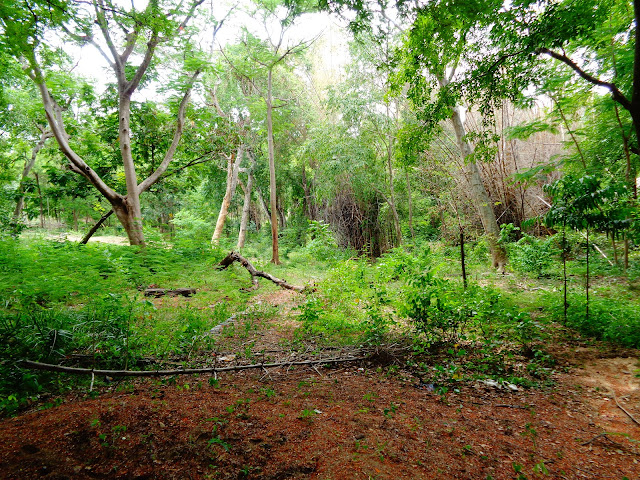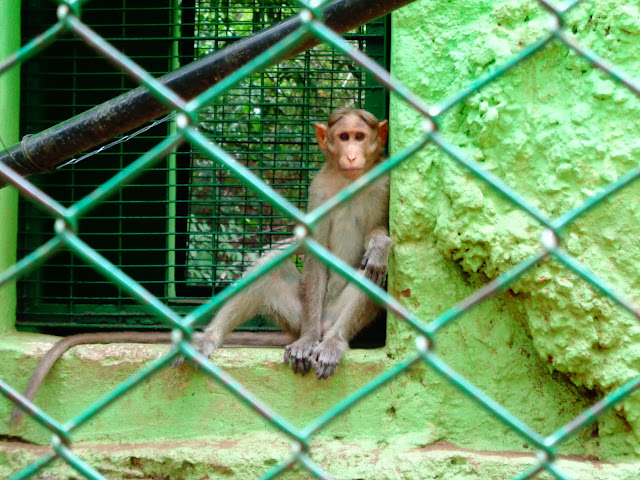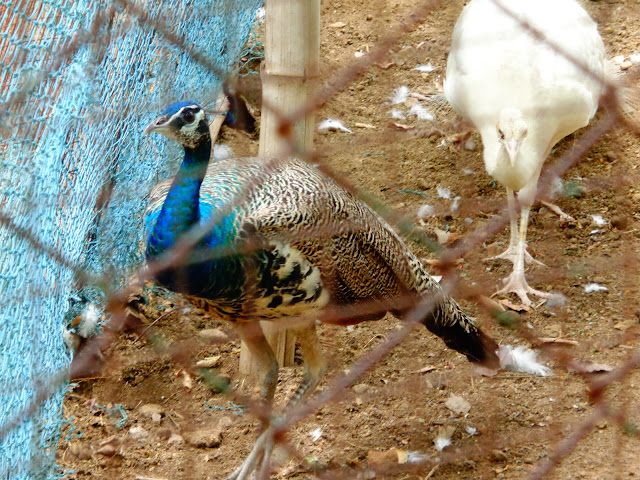 |
| Kurumbapatty Zoological park |
My Travelogues
Direction Board:
We can find this board at the entrance of Zoo.
Way to Kurumbapatti (Salem) Forest
 |
| Old Bridge at Zoological park |
Bamboo Forest
 |
| Golden Bamboo Stem |
Bambusa vulgaris forms moderately loose clumps and has no thorns. It has lemon-yellow culms (stems) with green stripes and dark green leaves. Stems are not straight, not easy to split, inflexible, thick-walled, and initially strong. The densely tufted culms grow 10–20 m (30–70 ft) high and 4–10 cm (2–4 in) thick. Culms are basally straight or flexuose (bent alternately in different directions), drooping at the tips. Culm walls are slightly thick. Nodes are slightly inflated. Internodes are 20–45 cm (7.9–17.7 in). Several branches develop from mid-culm nodes and above. Culm leaves are deciduous with dense pubescence. Leaf blades are narrowly lanceolate.
Flowering is not common, and there are no seeds. Fruits are rare due to low pollen viability caused by irregular meiosis. At the interval of several decades, the whole population of an area blooms at once, and individual stems bear a large number of flowers. Vegetation propagates through clump division, by rhizome, stem and branch cutting, layering, and marcotting. The easiest and most practised cultivation method is culm or branch cutting. In the Philippines, the best results were obtained from one-node cuttings from the lower parts of six-month-old culms. When a stem dies, the clump usually survives.[7] A clump can grow out of stem used for poles, fences, props, stakes, or posts. Its rhizomes extend up to 80 cm before turning upward to create open, fast-spreading clumps.The easy propagation of B. vulgaris explains its seemingly wild occurrence.
Some of the animals at Zoo:
Monkeys:
The bonnet macaque (Macaca radiata) is a macaque endemic to southern India. Its distribution is limited by the Indian Ocean on three sides and the Godavari and Tapti Rivers along with a related competing species of rhesus macaque in the north. Land use changes in the last few decades have resulted in changes in its distribution boundaries with the rhesus macaque, raising concern for its status in the wild.
The bonnet macaque feeds on fruits, nuts, seeds, flowers, invertebrates, and cereals. In southern India, this macaque exists as commensal to humans, feeding on food given by humans and raiding crops and houses.
Elephants:
The Indian elephant (Elephas maximus indicus) is one of three recognized subspecies of the Asian elephant and native to mainland Asia. Since 1986, Elephas maximus has been listed as Endangered by IUCN as the population has declined by at least 50% over the last 60 to 75 years or three generations. Asian elephants are threatened by habitat loss, degradation and fragmentation.
In general, Asian elephants are smaller than African elephants and have the highest body point on the head. The tip of their trunk has one finger-like process. Their back is convex or level. Indian elephants reach a shoulder height of between 2 and 3.5 m (6.6 and 11.5 ft), weigh between 2,000 and 5,000 kg (4,400 and 11,000 lb), and have 19 pairs of ribs. Their skin color is lighter than of maximus with smaller patches of depigmentation, but darker than of sumatranus. Females are usually smaller than males, and have short or no tusks.
Indian elephants have smaller ears, but relatively broader skulls and larger trunks than African elephants. Toes are large and broad. Unlike their African cousins, their abdomen is proportionate with their body weight but the African elephant has a large abdomen as compared to the skulls.
Snakes:
Indian Cobra
The Indian cobra (Naja naja) also known as the spectacled cobra, Asian cobra or binocellate cobra is a species of the genus Naja found in the Indian subcontinent (India, Pakistan, Bangladesh, Sri Lanka, Nepal) and a member of the "big four" species that inflict the most snakebites on humans in India. This snake is revered in Indian mythology and culture, and is often seen with snake charmers. It is now protected in India under the Indian Wildlife Protection Act (1972).
Common Rat Snake
Rat snakes (or ratsnakes) are members – along with kingsnakes, milk snakes, vine snakes and indigo snakes – of the subfamily Colubrinae of the family Colubridae. They are medium to large constrictors and are found throughout much of the Northern Hemisphere. They feed primarily on rodents and birds. With some species exceeding 3 m (10 ft) in total length, they can occupy top levels of some food chains. Many species make attractive and docile pets and one, the corn snake, is one of the most popular reptile pets in the world. Other species can be very skittish and sometimes aggressive, but bites are rarely serious. Like nearly all colubrids, rat snakes pose no threat to humans. Rat snakes were long thought to be completely nonvenomous, but recent studies have shown that some Old World species do possess small amounts of venom, though the amount is negligible relative to humans.
Previously, most rat snakes were assigned to the genus Elaphe, but many have been since renamed following mitochondrial DNA analysis performed in 2002. For the purpose of this article, names will be harmonized with the TIGR Database
Sambar Deer
Sambar are nocturnal or crepuscular. The males live alone for much of the year, and the females live in small herds of up to sixteen individuals. Indeed, in some areas, the average herd consists of only three or four individuals, typically consisting of an adult female, her most recent young, and perhaps a subordinate, immature female. This is an unusual pattern for deer, which more commonly live in larger groups. They often congregate near water, and are good swimmers. Like most deer, sambar are generally quiet, although all adults can scream or make short, high-pitched sounds when alarmed. However, they more commonly communicate by scent marking and foot stamping.
Sambar feed on a wide variety of vegetation, including grasses, foliage, browse, fruit, and water plants, depending on the local habitat. They also consume a great variety of shrubs and trees.
Birds
Peafowl
 |
| White Peacock |
Peafowl are forest birds that nest on the ground, but roost in trees. They are terrestrial feeders. All species of peafowl are believed to be polygamous. In common with other members of the Galliformes, the males possess metatarsal spurs or "thorns" on their legs used during intraspecific territorial fights with other members of their kind.
Peafowl are omnivores and eat mostly plant parts, flower petals, seed heads, insects and other arthropods, reptiles, and amphibians. Wild peafowl look for their food scratching around in leaf litter either early in the morning or at dusk. They retreat to the shade and security of the woods for the hottest portion of the day. These birds are not picky and will eat almost anything they can fit in their beak and digest. They actively hunt insects like ants, crickets and termites; millipedes; and other arthropods and small mammals. Indian peafowl also eat small snakes
Rose Ringed Parakeet
The rose-ringed parakeet (Psittacula krameri), also known as the ring-necked parakeet, is a gregarious tropical Afro-Asian parakeet species that has an extremely large range.
The rose-ringed parakeet is sexually dimorphic. The adult male sports a red or black neck ring and the hen and immature birds of both sexes either show no neck rings, or display shadow-like pale to dark grey neck rings. Both sexes have a distinctive green colour. Rose-ringed parakeets measure on average 40 cm (16 in) in length, including the tail feathers, a large portion of their total length. Their average single-wing length is about 15–17.5 cm (5.9–6.9 in). In the wild, this is a noisy species with an unmistakable squawking call. It is herbivorous and not migratory.
One of the few parrot species that have successfully adapted to living in disturbed habitats, it has withstood the onslaught of urbanisation and deforestation. As a popular pet species, escaped birds have colonised a number of cities around the world, including Northern and Western Europe, where they have been able to tolerate ambient temperatures far lower than those in their native range. Since the population appears to be increasing, the species was evaluated as being of least concern by the IUCN in 2012, but its popularity as a pet and unpopularity with farmers have both reduced its numbers in some parts of its native range.
Red-billed Pigeon
The red-billed pigeon (Patagioenas flavirostris) is a relatively large pigeon which breeds from southern Texas, United States, and northwestern Mexico south to Costa Rica. It belongs to a clade of Patagioenas which generally lack iridescent display plumage, except some vestiges in the pale-vented pigeon.
It is found in open country with some trees, large clearings and cultivation in lowlands and middle altitudes to 2,100 m (6,900 ft). It builds a rudimentary platform nest out of twigs in a tree about 4–25 m (13–82 ft) above the ground, usually on a horizontal branch or on a palm crown, and lays one white egg.
The red-billed pigeon is mid or large-sized pigeon, at 30–37 cm (12–15 in) in length and a weight of 230–425 g (8.1–15.0 oz). It is mainly wine-purple, becoming browner on the back, and with a grey tail, lower belly and flight feathers. The bill is white with a red base, and the legs and eyes are red. Juvenile birds are duller than adults and the plumage is brown-tinged.
It is normally seen alone or in pairs and rarely forms flocks. It feeds on the ground, seeking acorns, berries and buds.
It is often thought to be brown it is actually a dark shade of maroon.
Water birds
Spot-billed pelican
The spot-billed pelican is a relatively small pelican but still a large bird. It is 125–152 cm (49–60 in) long and a weight of 4.1–6 kg (9.0–13.2 lb). It is mainly white, with a grey crest, hindneck and a brownish tail. The feathers on the hind neck are curly and form a greyish nape crest. The pouch is pink to purplish and has large pale spots, and is also spotted on the sides of the upper mandible. The tip of the bill (or nail) is yellow to orange. In breeding plumage, the skin at the base of the beak is dark and the orbital patch is pink. In flight they look not unlike the Dalmatian pelican but the tertials and inner secondaries are darker and a pale band runs along the greater coverts. The tail is rounder.
The newly hatched young are covered in white down. They then moult into a greyish speckled plumage. The spots on the bill appear only after a year. The full adult breeding plumage appears in their third year.
Seagull
Gulls range in size from the little gull, at 120 g (4.2 oz) and 29 cm (11 in), to the great black-backed gull, at 1.75 kg (3.9 lb) and 76 cm (30 in). They are generally uniform in shape, with heavy bodies, long wings, and moderately long necks. The tails of all but three species are rounded; the exceptions being Sabine's gull and swallow-tailed gulls, which have forked tails, and Ross's gull, which has a wedge-shaped tail. Gulls have moderately long legs, especially when compared to the similar terns, with fully webbed feet. The bill is generally heavy and slightly hooked, with the larger species having stouter bills than the smaller species. The bill colour is often yellow with a red spot for the larger white-headed species and red, dark red or black in the smaller species.
The gulls are generalist feeders. Indeed, they are the least specialised of all the seabirds, and their morphology allows for equal adeptness in swimming, flying, and walking. They are more adept walking on land than most other seabirds, and the smaller gulls tend to be more manoeuvrable while walking. The walking gait of gulls includes a slight side to side motion, something that can be exaggerated in breeding displays. In the air, they are able to hover and they are also able to take off quickly with little space.
The general pattern of plumage in adult gulls is a white body with a darker mantle; the extent to which the mantle is darker varies from pale grey to black. A few species vary in this, the ivory gull is entirely white, and some like the lava gull and Heermann's gull have partly or entirely grey bodies. The wingtips of most species are black, which improves their resistance to wear and tear, usually with a diagnostic pattern of white markings. The head of a gull may be covered by a dark hood or be entirely white. The plumage of the head varies by breeding season; in nonbreeding dark-hooded gulls, the hood is lost, sometimes leaving a single spot behind the eye, and in white-headed gulls, nonbreeding heads may have streaking.
















Comments
Post a Comment